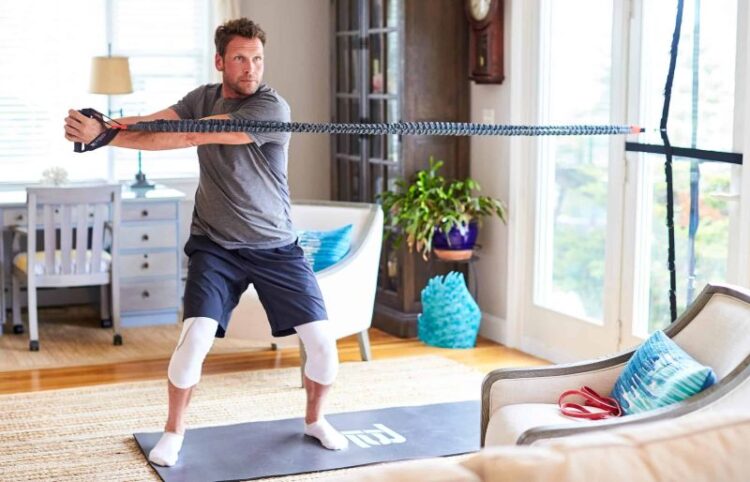Resistance bands are an excellent tool for building strength, stability, balance, and focus. But did you know that resistance bands are also a powerful ally in looking after our mental health? And the beautiful thing about resistance bands is that you don’t need a gym membership to use them. You don’t need a personal trainer, either. All you need is a place to work out and an exercise plan. Simple!
Let’s look at some of the most common mental health challenges that people face and how they can be improved using resistance band training.
Page Contents
Resistance band training and anxiety

source:tb12sports.com
Resistance training (also called weight training or strength training) can not only build your muscle mass and tone your body. Even a small amount of resistance training has been proven to help anxiety, which is no small thing, given that anxiety affects more than 40 million Americans and 284 million people worldwide.
Training with resistance has also been shown to help reduce what is called anxiety sensitivity – the fear of anxiety levels rising. Some people associate a racing heartbeat with a possible impending heart attack, even if that isn’t the case. Resistance training helps people reduce anxiety sensitivity – more so than aerobic exercise, or even just not exercising.
When you are doing your resistance training, make sure you incorporate short rest periods. These rest times will allow any anxious sensations to decrease before you start the next bout of exercise. In this way, you expose yourself to situations in small doses over time, and your ‘recovery time’ will improve with each workout.
The more you can experience a situation such as a racing heartbeat without anything awful happening, the more your fear of that situation starts to fade. When you are then at work or in other situations where you might experience anxiety, these positive experiences during exercise can help the body learn to relax and breathe instead of overreacting.
For best results with anxiety, work out with a low-to-moderate intensity level, and keep it up for 6 weeks or longer.
How to calculate exercise intensity levels

source:gaiam.com
You can check your exercise intensity by checking your maximum heart rate (MHR). To work out your MHR, subtract your age from 220 to get the beats per minute.
For example, a 50-year-old would have an MHR of 220 – 50 = 170 beats per minute.
Low-intensity activity gets your MHR up to about 40 to 50 percent. Moderate-intensity activity gets your MHR up to about 50 to 70 percent.
To check your heartbeat without the use of a fitness wrist band, take your pulse for 15 seconds while counting the beats. Times this figure by four to get your heartbeat.
Or to keep things even simpler, you can do the ‘talk test’. If you can sing or talk while exercising without getting out of breath, you’re exercising at a low-intensity rate. If you can speak or sing for only a few words before getting out of breath, you’re exercising at a moderate-intensity rate.
Resistance band training and depression

source:tb12sports.com
According to the WHO (World Health Organisation), 264 million people worldwide suffer from depression. It is widely understood that exercise can be a big help in fighting depression.
But did you know the importance of doing flexibility exercises for depression? Have a look at this study, which shows that participants who participated in flexibility exercises were less likely to have episodes of depression than those who did not.
Resistance bands, as we said at the start, are great for flexibility training. They work on several muscles at once, including the areas around our joints. There is greater freedom of movement within resistance band exercises, so your body has many ways to move and build strength.
These days most of us know that exercise can help with depression, but we tend to think you have to run or do aerobics or something else that leaves you very tired. However, even an hour a week of flexibility training has been sufficient to alleviate depression symptoms. The benefits extend beyond the immediate time following exercise.
Resistance band training and stress

source:realsimple.com
If you worry a lot, you’ll be glad to know that resistance training can also help with stress, and even with the quality of your sleep.
Poor-quality sleep is often a by-product of anxiety and stress. By using resistance training to combat stress, you’re also fighting the tendency that we all have to worry about things that make us anxious before trying to fall asleep.
Working out with resistance bands or weights for just twice a week over six weeks can be enough to notice less stress and better quality sleep.
If you’re someone who gets tension headaches, resistance bands can help there too. By using the bands to tone your back, neck, and shoulder muscles, you will get your blood flowing. You’ll be taking in more oxygen, which then can clear your mind as the oxygen helps you breathe.
There is also a significant mindfulness component when training with resistance bands, as you need to remain focused on where your body is in space. To hold the positions while working against the resistance band’s tension, you have to concentrate and stay present. Focusing on physical movement takes your mind away from any stress you might have been feeling previously.
Tips for resistance training for improving mental health
Here are some final tips for using resistance training to improve mental health.
Get yourself some resistance bands
Even more so than weights, resistance bands (like these) are vital in improving your strength and tone, and flexibility.
Resistance bands are suitable for all ages and abilities, and it’s easy to adjust the difficulties of the exercises by having different sizes and strengths of bands.
Work out consistently
Once you start your resistance band training, keep it up. If you stop exercising regularly, depression symptoms can worsen in as little as 3 days of no activity.
Find a resistance band workout you enjoy, get training, and reap the rewards!





